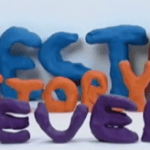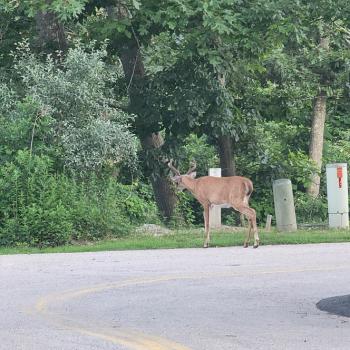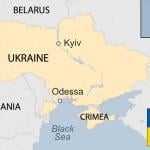I have a colleague and friend with whom I share a lot in common. Eric and I are both “Johnnies,” graduates of the St. John’s College Great Books curriculum (he graduated a few years before I did in the seventies).  We are both Simone Weil scholars and aficionados (he founded the American Weil Society more than thirty years ago). He was an outside reader on one of my books, as I was on one of his a few years later. And we are both hardcore Protestants. I write about my Baptist roots frequently in this blog; Eric is an ordained Presbyterian minister who has been a theology professor, a college chaplain, and for the past several years has been a hired-gun interim pastor for several large Presbyterian congregations on the Eastern seaboard.
We are both Simone Weil scholars and aficionados (he founded the American Weil Society more than thirty years ago). He was an outside reader on one of my books, as I was on one of his a few years later. And we are both hardcore Protestants. I write about my Baptist roots frequently in this blog; Eric is an ordained Presbyterian minister who has been a theology professor, a college chaplain, and for the past several years has been a hired-gun interim pastor for several large Presbyterian congregations on the Eastern seaboard.
Eric and I see each other once a year at most at the annual Weil colloquies. A few years ago as we chatted at dinner I found myself describing my professional life as a non-Catholic who has been teaching philosophy in Catholic institutions of higher learning for more than two decades. “I could never be a Catholic,” Eric observed. “I just don’t get that Mary thing.” But I love Advent, Mary is a major Advent player,  so every year I get to think about the Mary phenomenon once again.
so every year I get to think about the Mary phenomenon once again.
A couple of years ago I read Colm Toibin’s novella The Testament of Mary. Toibin places the reader in the mind of Mary many years after her son was crucified. She is full of guilt and bitterness, has little use for Matthew and John who visit on occasion to fact check their accounts of Jesus’ life, and is convinced that her son’s death was not worth it. The book is not for the Christian faint of heart—the gentle, submissive, ethereal, and holy Mary of tradition and art masterpieces is nowhere to be found. But as always, I found it exhilarating to consider a religious icon as the flesh-and-blood human being that she was.
I believe that over the centuries Christians have made two mistakes concerning Mary. We have treated her either as a museum piece or as a holy relic. In the tradition I grew up in, we treated Mary as a museum piece. The only time I ever heard about Mary was around Christmas or if the text for the day was the marriage at Cana when Jesus is unaccountably rude to her. At Christmas, Mary showed up in the pageant. I remember in various Christmas pageants being the innkeeper, a wise man, a shepherd—all of the usual male roles; once I even got to be Joseph. So there was a Mary wing in the Baptist Christian museum of my youth, but it was small and uninteresting.
I remember in various Christmas pageants being the innkeeper, a wise man, a shepherd—all of the usual male roles; once I even got to be Joseph. So there was a Mary wing in the Baptist Christian museum of my youth, but it was small and uninteresting.
In other Christian traditions, such as the one in which Jeanne grew up, Mary plays a slightly more central role. In these churches Mary often gets more face time in artistic representations than Jesus himself. Attention to Mary has evolved into complicated ritualistic forms which in some cases border on the cultish. ![San+Gennaro+Festival+Returns+New+York+Little+1r1OJyXXSo3l[1]](https://wp-media.patheos.com/blogs/sites/766/2012/12/sangennarofestivalreturnsnewyorklittle1r1ojyxxso3l1.jpg?w=300) You may remember a scene from the movie Godfather II in which a much larger than life statue of Mary is carried reverently through the streets of Manhattan as onlookers attach dollar bills to her. Jeanne tells me that such Mary-as-a-holy-relic events are by no means uncommon—if it’s Tuesday, it must be time for another Mary parade!
You may remember a scene from the movie Godfather II in which a much larger than life statue of Mary is carried reverently through the streets of Manhattan as onlookers attach dollar bills to her. Jeanne tells me that such Mary-as-a-holy-relic events are by no means uncommon—if it’s Tuesday, it must be time for another Mary parade!
Because we have either placed her virtually behind glass or smothered her in ritual, Mary has been effectively hidden from us. But if Mary is neither a museum piece nor a holy relic, who or what is she?
From the few details provided in the gospels, joined together with what we know about the culture in which she lived, we can sketchily picture Mary. Mary is young, most likely in her early teens.![2006_the_nativity_story_007[1]](https://wp-media.patheos.com/blogs/sites/766/2012/12/2006_the_nativity_story_0071.jpg?w=150) She is engaged to Joseph, a man much older than Mary, an engagement arranged between Joseph and Mary’s father. Mary is almost certainly poor. Her skin is darker than suggested in traditional artwork. She has dirt under her fingernails. We do not know whether she has siblings, nor do we know from the gospels anything about her parents. She’s nothing special, just an insignificant young girl living in a nothing town in the eastern backwater of the Roman Empire. And she is visited by an angel.
She is engaged to Joseph, a man much older than Mary, an engagement arranged between Joseph and Mary’s father. Mary is almost certainly poor. Her skin is darker than suggested in traditional artwork. She has dirt under her fingernails. We do not know whether she has siblings, nor do we know from the gospels anything about her parents. She’s nothing special, just an insignificant young girl living in a nothing town in the eastern backwater of the Roman Empire. And she is visited by an angel.
In scripture, angels are always the heralds of new beginnings, inviting us to adventure. They introduce mystery—they do not clarify. Angels announce new departures and the beginning of something whose end is not in view. This particular angel’s announcement to Mary is an explosion of beauty from the first sentence: ![annunciation1[1]](https://wp-media.patheos.com/blogs/sites/766/2012/12/annunciation11.jpg?w=300) “Greetings, favored one—the Lord is with you.” And in the narrative of incarnation that Advent prepares us for, the Lord is with all of us. “Greetings, favored ones—the Lord is with us.” We are all too aware of our humanity, of our shortcomings and failings, that we bear the burden, as John Henry Newman wrote, of “some aboriginal calamity.” But we are also the bearers of the divine. The promise of incarnation is that God chooses, inexplicably, miraculously, to inhabit flawed and imperfect matter, to become human. The promise to Mary is the promise to us—the Lord is with us. We, as Mary, are the wombs from which the divine enters the world each day. We are the incubators of God. Mary’s response to Gabriel is the only one possible—“How can this be?” It is a mystery. It is also a great story.
“Greetings, favored one—the Lord is with you.” And in the narrative of incarnation that Advent prepares us for, the Lord is with all of us. “Greetings, favored ones—the Lord is with us.” We are all too aware of our humanity, of our shortcomings and failings, that we bear the burden, as John Henry Newman wrote, of “some aboriginal calamity.” But we are also the bearers of the divine. The promise of incarnation is that God chooses, inexplicably, miraculously, to inhabit flawed and imperfect matter, to become human. The promise to Mary is the promise to us—the Lord is with us. We, as Mary, are the wombs from which the divine enters the world each day. We are the incubators of God. Mary’s response to Gabriel is the only one possible—“How can this be?” It is a mystery. It is also a great story.
When Mary gathers herself sufficiently to comment on the angel’s announcement after he leaves, she begins in the right place. “For he has looked with favor on the lowliness of his servant. Surely, from now on all generations will call me blessed.” Mary is saying that “I’m nothing special. I’m just a garden variety human being. But the divine has shown favor toward me and has bestowed blessing on me by choosing to inhabit me.” There is only one possible reason for this favor, because Mary knows that she has done nothing to earn it. This reason is love. Love is holy because it is a lot like grace—the worthiness of its object is never really what matters. The astounding mystery and wonder of God’s love for us permeates throughout the beautiful story of the Annunciation. This favor and blessing continues. ![hands_and_feet_2[1]](https://wp-media.patheos.com/blogs/sites/766/2012/12/hands_and_feet_21.jpg) The incarnation narrative—the story of God becoming flesh—is a direct response to our inherent flaws, imperfections, limitations, and evil. Divine favor and blessing is offered to all of us. And the status of humanity is raised when God inhabits it. I remember singing a Sunday School song that included the lines “we are his hands, we are his feet.” That is the mystery, the scandal, and the beauty of the incarnation story: God entrusts flawed human beings to be the divine in the world.
The incarnation narrative—the story of God becoming flesh—is a direct response to our inherent flaws, imperfections, limitations, and evil. Divine favor and blessing is offered to all of us. And the status of humanity is raised when God inhabits it. I remember singing a Sunday School song that included the lines “we are his hands, we are his feet.” That is the mystery, the scandal, and the beauty of the incarnation story: God entrusts flawed human beings to be the divine in the world.
At St. John’s University and Abbey in Collegeville Minnesota, Benedictine priest![diekmann[1]](http://wp.production.patheos.com/blogs/freelancechristianity/files/2012/12/diekmann1.jpg?w=98) Godfrey Diekmann was a rock star. He and his mentor, Fr. Virgil Michael, were perhaps more responsible for liturgical reform and renewal in the Catholic Church than any others. When I was a resident scholar at an ecumenical institute at St. John’s in the Spring 2009 semester, I heard many Godfrey Diekmann stories—his wit as well as his temper were legendary. My favorite of these stories might be apocryphal, but I heard it so often that I suspect it is true. One evening while eating with colleagues and students in the student dining room, Diekmann got involved in a spirited conversation about the heart of Christian theology and life. He startled those at his table as well as those within earshot by slamming his hand on the table and shouting “It’s not the Resurrection, god-dammit! It’s the Incarnation!” As students, stunned into silence, slipped away he added “But we don’t believe it. We don’t believe that we are invited to become the very life of God.” The Christmas we anticipate—that is incubating in each of us—is the moment of salvation as God enters time, history, and each of us.
Godfrey Diekmann was a rock star. He and his mentor, Fr. Virgil Michael, were perhaps more responsible for liturgical reform and renewal in the Catholic Church than any others. When I was a resident scholar at an ecumenical institute at St. John’s in the Spring 2009 semester, I heard many Godfrey Diekmann stories—his wit as well as his temper were legendary. My favorite of these stories might be apocryphal, but I heard it so often that I suspect it is true. One evening while eating with colleagues and students in the student dining room, Diekmann got involved in a spirited conversation about the heart of Christian theology and life. He startled those at his table as well as those within earshot by slamming his hand on the table and shouting “It’s not the Resurrection, god-dammit! It’s the Incarnation!” As students, stunned into silence, slipped away he added “But we don’t believe it. We don’t believe that we are invited to become the very life of God.” The Christmas we anticipate—that is incubating in each of us—is the moment of salvation as God enters time, history, and each of us.![matthew_fox_original_blessing[1]](https://wp-media.patheos.com/blogs/sites/766/2012/12/matthew_fox_original_blessing1.jpg?w=98)
We are His hands. We are his feet. It almost makes me agree with former Dominican Matthew Fox, who has argued for years that the doctrine of original sin should be replaced with the doctrine of original blessing.
 Advent’s strongest image is pregnancy. Elizabeth’s . . . Mary’s . . . so unexpected, so miraculous. Advent reminds us that in our lives there is always a child ready to enter the world—the divine child that is in each of us and the child of God that each of us is. So here we all are, favored of God, loved by God, regardless of whether we feel it or deserve it. A great gift has been placed in us, a gift that carries with it unlimited responsibility. How will we nurture this child? How will we bring it to birth? What is incubating in each of us is as individual and unique as each of us is—and it is divine. How will we welcome this child? Mary’s response must be ours: “Here we are, the servants of the Lord. Let it be with us according to your Word.”
Advent’s strongest image is pregnancy. Elizabeth’s . . . Mary’s . . . so unexpected, so miraculous. Advent reminds us that in our lives there is always a child ready to enter the world—the divine child that is in each of us and the child of God that each of us is. So here we all are, favored of God, loved by God, regardless of whether we feel it or deserve it. A great gift has been placed in us, a gift that carries with it unlimited responsibility. How will we nurture this child? How will we bring it to birth? What is incubating in each of us is as individual and unique as each of us is—and it is divine. How will we welcome this child? Mary’s response must be ours: “Here we are, the servants of the Lord. Let it be with us according to your Word.”












